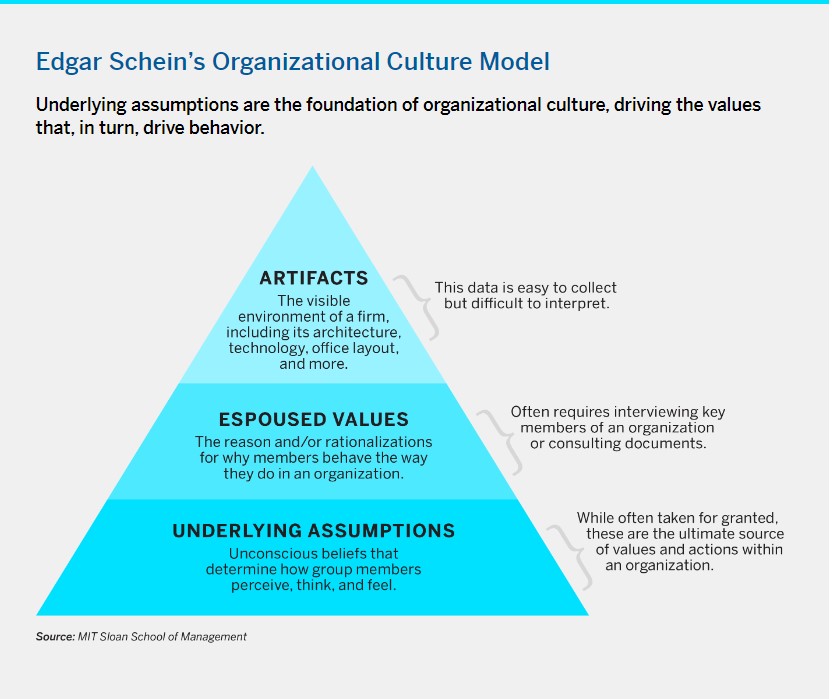Take a Skills-Based Approach to Culture Change
Applying new skills to meaningful problems at the learning stage helps turn skeptics into evangelists and achieve lasting cultural change.
Topics
Leading With Impact
News
- UAE Approves National Encryption Policy for a Post-Quantum Shift
- OpenAI API Users Hit With Third-Party Security Breach
- Uber and WeRide Launch First Driverless Robotaxi Service Outside the U.S. and China
- UAE Unveils Its First Marketplace for Buying and Trading Trademarks
- ACI Flags Sharp Rise in ‘Friendly Fraud’ as Thanksgiving–Cyber Monday Spike Looms
- WhatsApp’s AI Clampdown to Send Microsoft Copilot Packing by Jan 2026

Companies worldwide are launching interventions to create innovative organizational cultures that support effective responses to shifts in their business environments. But many well-intentioned programs aimed at cultural change fail to affect employees in a meaningful way, leaving organizations unfit for transformation despite having invested hundreds or even thousands of employee hours.
Unlike most types of culture initiatives, a skills-based approach can more effectively infuse new culture components into scale-ups and international incumbents alike. This approach is particularly effective for developing what many refer to as soft skills, such as perspective taking. This ability to step outside one’s own perspective to understand another person’s point of view, motivations, and emotions helps build a psychologically safe environment in which people dare to share ideas and unfiltered information.
The most important aspect of a skills-based approach to culture change is quickly linking newly acquired soft skills to bottom-line results and progress on tough, important challenges. As described in the Harvard Business School case “Leading Culture Change at SEB,” teams that learned and applied such skills to real-life business challenges at the financial services company created momentum for culture change. Members of the first team that participated in the training program at SEB said that the strategies they learned helped them get past a crucial strategic challenge they had been struggling with for years. Another SEB team noted that the training led to increases in customer acquisitions and market share. And one executive-level participant said, “The results came quicker than we expected … in the shape of quicker decisions, better decisions … [for] problems that had been around for a long time. We were able to solve them relatively quickly.”
The skills-based approach rests on two important frameworks. The first is the late Edgar Schein’s organizational culture model, in which culture builds upon a foundation of basic underlying assumptions — employees’ shared assumptions about what drives successful outcomes to challenges in their organization’s specific context. Underlying assumptions — the ultimate source of values and action — are so deeply embedded that employees behave in accordance with them without thinking about it. Changing culture, then, requires a basis of new assumptions. (See “Edgar Schein’s Organizational Culture Model.”)
Edgar Schein’s Organizational Culture Model
Underlying assumptions are the foundation of organizational culture, driving the values that, in turn, drive behavior.

The second model is based on what Nelson Repenning termed a capability trap, which describes how organizations fail to implement capabilities that have proved to create a positive effect. One of the main reasons behind this failure is a delay in the feedback loop between investing in a capability (such as perspective taking) and recognizing the rewards (more innovation and better decisions). If the price of improving the capability — time, focus, and resources — is immediate but the rewards aren’t soon obvious, people are likely to revert to old ways of doing things before ever realizing the new capability’s potential. However, cutting that feedback loop short so people more immediately experience how the new capability leads to successful outcomes can create a reinforcing loop that builds momentum for change and the use of the new skill.
Below, I will share some key attributes of the skills-based approach to culture change and how organizations can leverage it to speed the process and improve performance.
Why Most Culture-Change Initiatives Fail
Many culture-change initiatives build on a series of standardized workshops in which employees discuss new values and behaviors. From Schein’s model, it is clear that new values will have little effect on culture as long as the underlying assumptions that drive the actual values and behavior remain the same. Further, the approach of rolling out new values seldom leads to culture change, because the approach is highly susceptible to the capability trap; the price is enormous, taking hundreds of employees away from their work tasks for hours with little immediate effect on performance.
In contrast, the skills-based approach starts by helping a smaller team of individuals use new skills when addressing important business challenges. Through intense, focused interventions, participants link the skills to successful outcomes, thereby helping individuals change their assumptions. To create new assumptions about perspective taking, for example, employees must experience successful outcomes — on their specific challenges, in their particular organizational context — as a result of using the new cultural component. Inspirational speeches might help employees understand that perspective taking has worked in other organizations, but the underlying assumptions that sustain culture concern “what works in our context.”
When the skills prove to create successful outcomes, people will start to assume that they work, creating a “pull effect” as more people want to use the skills to make similar progress on their own challenges. Gradually, the skills become the normal way of doing things.
To infuse new skills into your organizational culture, focus on those that will make a substantial difference to the organization’s performance. SEB selected perspective taking and the ability to create a psychologically safe atmosphere because these skills support not only decision-making, innovation, and transformation but also collaboration, teaming, and inclusion.
The Danger of Testing the Waters
When too briefly introduced, even the most powerful skills will be misevaluated. Doing short workshops can lead to a situation resembling a group of people dipping their toes into a pool. They might think they understand the pool’s potential, but they haven’t yet jumped in and realized what it’s like to swim. Culture work is the same: Much too often, people falsely believe that they can evaluate the potential of a new skill after participating in a single workshop. The common approach to culture change — centered on rolling out new values and behaviors using short, standardized workshops — almost guarantees a “toe dipping” situation.
For real change, people need to learn new skills and put them to use on real problems — to dive into the pool fully. Once someone has jumped in and learned to swim, you have an example within the organization that can help others see what the pool is about. Hence, the skills-based approach depends on finding the first culture champion — a leader who is convinced that time and effort spent helping their team build new skills and putting them to use on their challenges will reap positive results.
Much too often, people falsely believe that they can evaluate the potential of a new skill after participating in a single workshop.
With “proof” that the skills work for one team, people will see for themselves how the new culture component leads to successful outcomes — in the organization’s specific context, on the organization’s specific challenges — thus speaking directly to underlying assumptions. This will recruit more champions and ready the organization for a more standardized rollout centered around colleagues’ stories of the new skills leading to successful outcomes.
Go Deep, Not Wide
It would be impossible for a full team to build a new skill and put it to use perfectly on the first try. Hence, planning for a longer process, where one team has the chance to gradually build individual skills and multiple chances to put the skills to use, helps to create a link between the skills and successful outcomes — which is key to developing new assumptions.
To ensure substantial, successful results, I propose a process that includes at least three full-day workshops, each containing structured dialogue to make progress on the team’s important challenges while practicing new skills and behaviors. This offers each participant several experiences linking the use of the skills to successful outcomes. Since a total of three or four days is a big ask for a management team, it’s essential that each workshop drives progress on a challenge high on the team’s agenda. This creates a short feedback loop, thus avoiding the capability trap while creating momentum for the change.
By first going deep with one team, SEB was able to create enough progress on important challenges that all team members, even those initially opposed to the large time investment, recognized that the gains exceeded the costs and effort spent. Demonstrating such progress is key to building momentum for cultural change and selling the approach to other teams.
Let Senior Leaders Experiment
It’s easy to get people to agree on the theoretical benefits of perspective taking and psychological safety and to get senior management to agree that such things should be infused into the organizational culture. However, changing habits, behavior, and established processes of working on decisive business challenges is a lot harder, especially for people who have practiced other behaviors for a long time.
Two decades of experimentation with culture-change methods have taught me that while younger employees may respond well to detailed instructions about behavior, the same instructions given to senior leaders can provoke unproductive responses, substantial resistance, and even downright refusal to participate. So instead, I describe the research and substantial benefits of using a specific skill — for example, taking someone else’s perspective. Then the participants themselves get to experiment with behavior that helps them with perspective taking. When logic and strong proof show them that perspective taking leads to better decisions, most executives will be open to trying it, which maximizes the chances of everyone joining in. As they experience how it creates progress on thorny challenges, they will start demonstrating the behavior more and more.
When people are practicing and developing the new skills, take an inclusive approach: Improving these skills can mean changing different behavior for different individuals. Some executives need to listen more and speak less, for example, while others need to be more curious, ask more questions, and speak more. It is hard to predict what behaviors will create success, so allow participants to explore and experiment until they find a way to practice the skill that works for them. Taking a team of senior leaders through an in-depth skills-building process before you ask them to promote the new skills can help support and drive a cultural initiative.
Allow Time to Win Over Skeptics
When attempting to infuse new skills into an organization’s culture, winning over skeptics — who become champions and openly share their new skills and altered assumptions with others — is very powerful. Short workshops will seldom be enough to turn skeptics and critics into promoters, so “going deep” is essential. The in-depth process gives the time, focus, and results needed to win over skeptics who are less likely to jump on the soft-skills bandwagon.
A team usually becomes positive about promoting new skills and practices to the rest of the organization — even eager to do it — once its members have experienced a collective change in assumptions and have seen how the new skill can benefit performance. Leverage the enthusiasm of these leaders. The more voices you hear from within the system, the better the chance you have to influence more people’s assumptions and thereby change the culture.
The SEB case describes how one highly influential individual openly questioned the intervention, doubting what the new skills had to offer. But halfway through the process, he decided to put the skills to use on an important issue that had halted strategic progress for a long time. After experiencing the progress that the skills helped create, he became a strong, vocal supporter of the approach. Another participant believed in the skills but was uncomfortable promoting “soft” terms like psychological safety. After making progress by applying the skills to complex problems, she was comfortable enough to stand on stage before her colleagues with real-life examples to share, wholeheartedly promoting the use of the skills to solve important challenges.
Each personal story of the skills working “in our context” will connect the skills to successful outcomes and serve as a powerful tool when the culture initiative is eventually introduced to the larger organization. To truly influence culture, postpone rolling anything out until you have accrued evidence that the new component creates successful outcomes in your environment.
Put the Skills to Use Quickly
To avoid the capability trap, make sure that the skills are put to use on real challenges as soon as possible. Refrain from long conversations about the skills; instead, move quickly into practice, allowing participants to experience using the skills on their own work challenges.
At SEB, the skills-based team process began with an offsite meeting. Within hours, the team had selected a few complex challenges that were important to the success of the organization. Through a structured dialogue leveraging perspective taking and psychological safety, the team made progress on things that really mattered to them. Team members left the workshop struck by how effective the new skills were, having experienced sufficient progress to justify the time spent away from their normal work tasks, and were motivated to further improve their skills.
Picture learning a new skill, like swimming or riding a bike. There is often an early phase of frustration before you figure out how to make it work. During this learning phase, it’s tempting to give up and revert to doing things the way you’re used to doing them. With this in mind, I use a series of intense, short, skill-building sessions in which participants visualize and share stories of recent situations where they have used the skill, followed by visualizing a future event where the skill could be used to create positive outcomes.
At SEB, these weekly sessions gave participants an experience of progress that carried them through the frustrating first phase of the learning curve. As team members improved their skills, they offered examples of their successful application to real-life challenges and opportunities. Every such example serves to reinforce the link between the skills and successful outcomes, gradually facilitating a shift in the team’s underlying assumptions about the skills.
To influence culture, you have to help people make new assumptions, so offering “proof” that a new skill works within the organization’s context is crucial. To create such proof, find one senior leader who is willing to take the time to train and apply the new skills with their team. Once stories emerge that link the new skill to success on important business challenges, use them to recruit more leaders to create even more stories that, in turn, can attract even more leaders. Implementing such a “pull” strategy centered on sharing success stories, along with widely available skills training, is an effective way to create an organizational culture that supports innovation and transformation.





